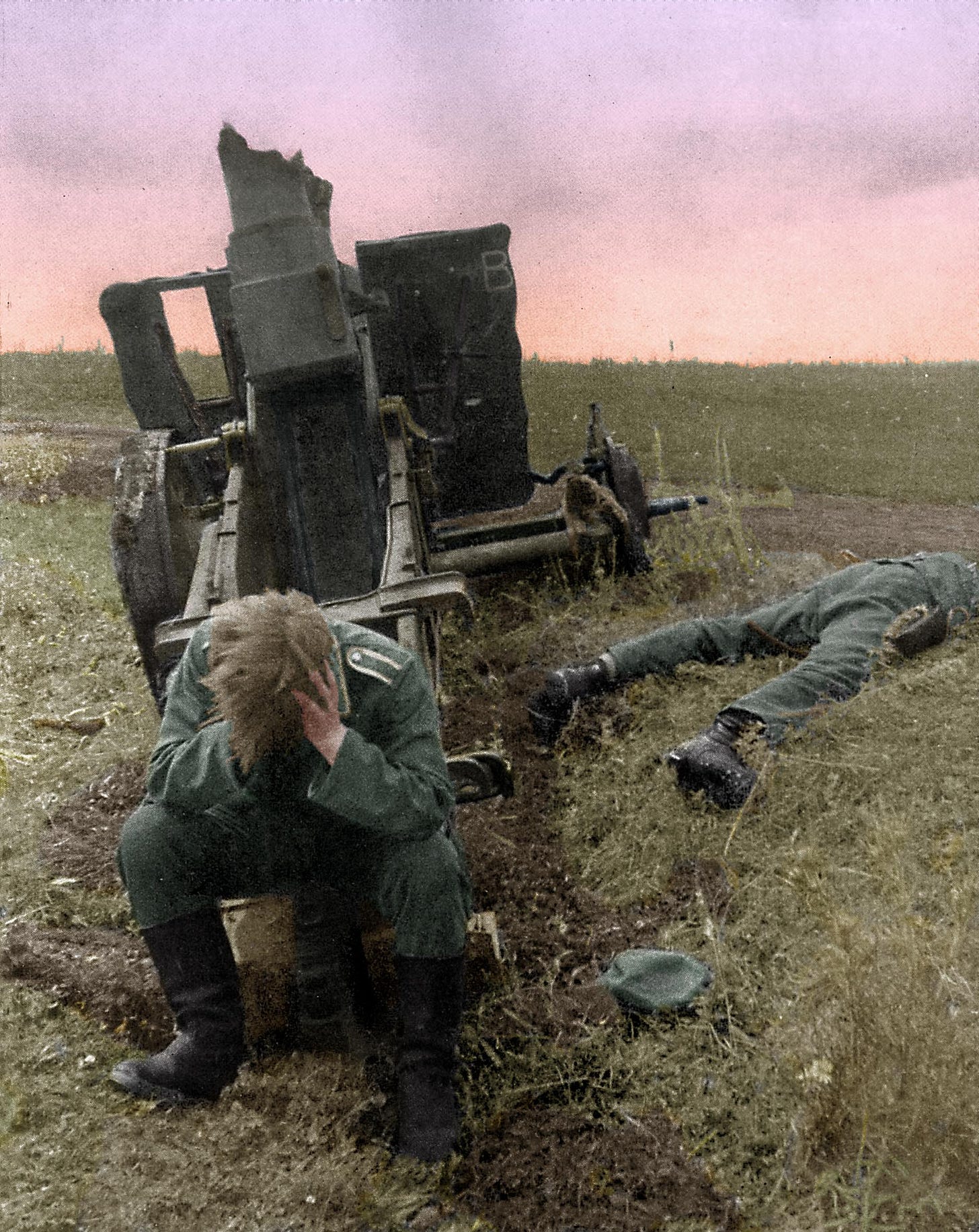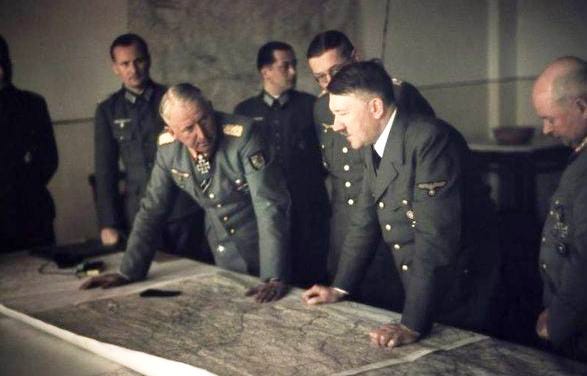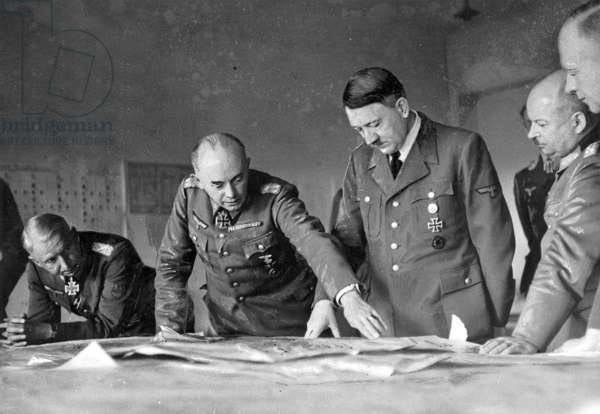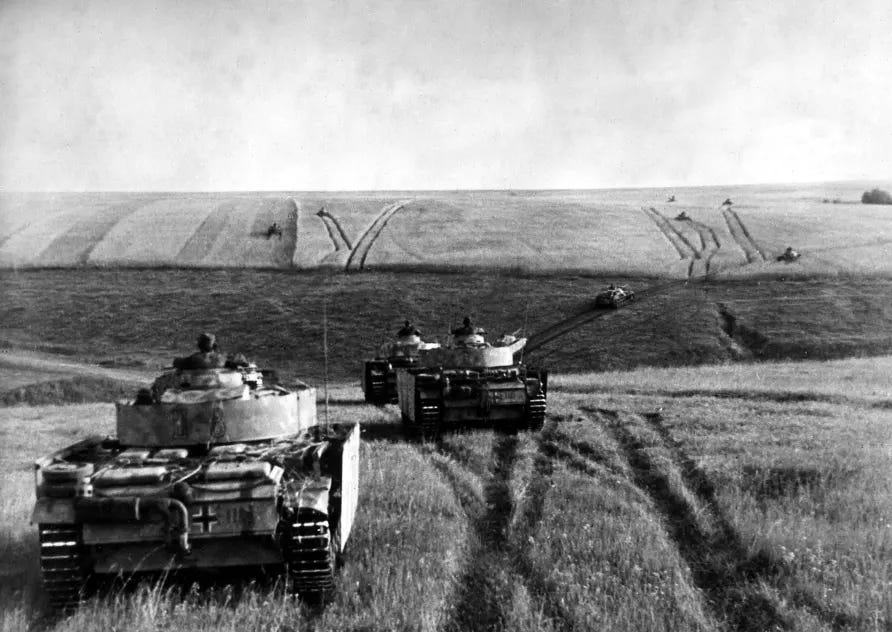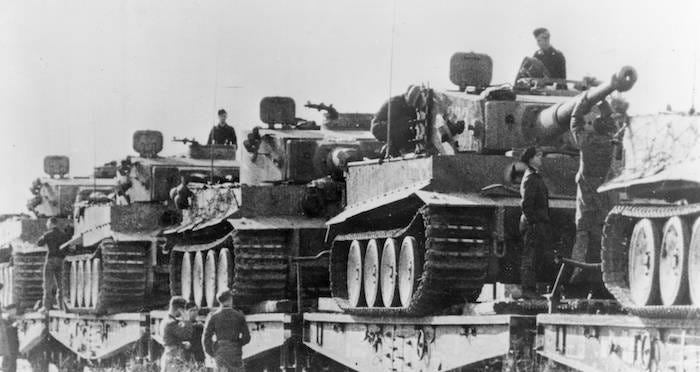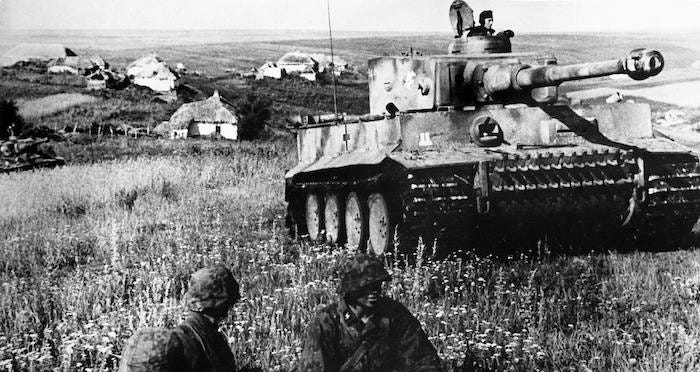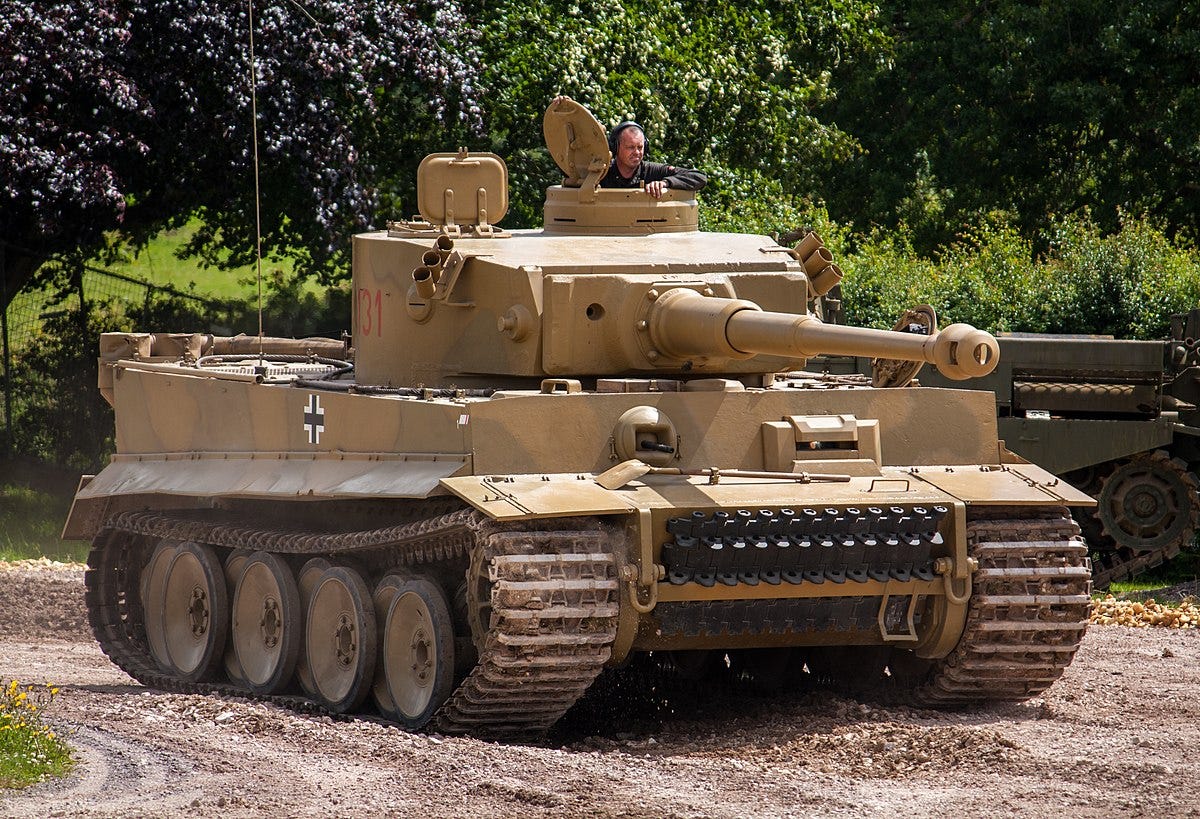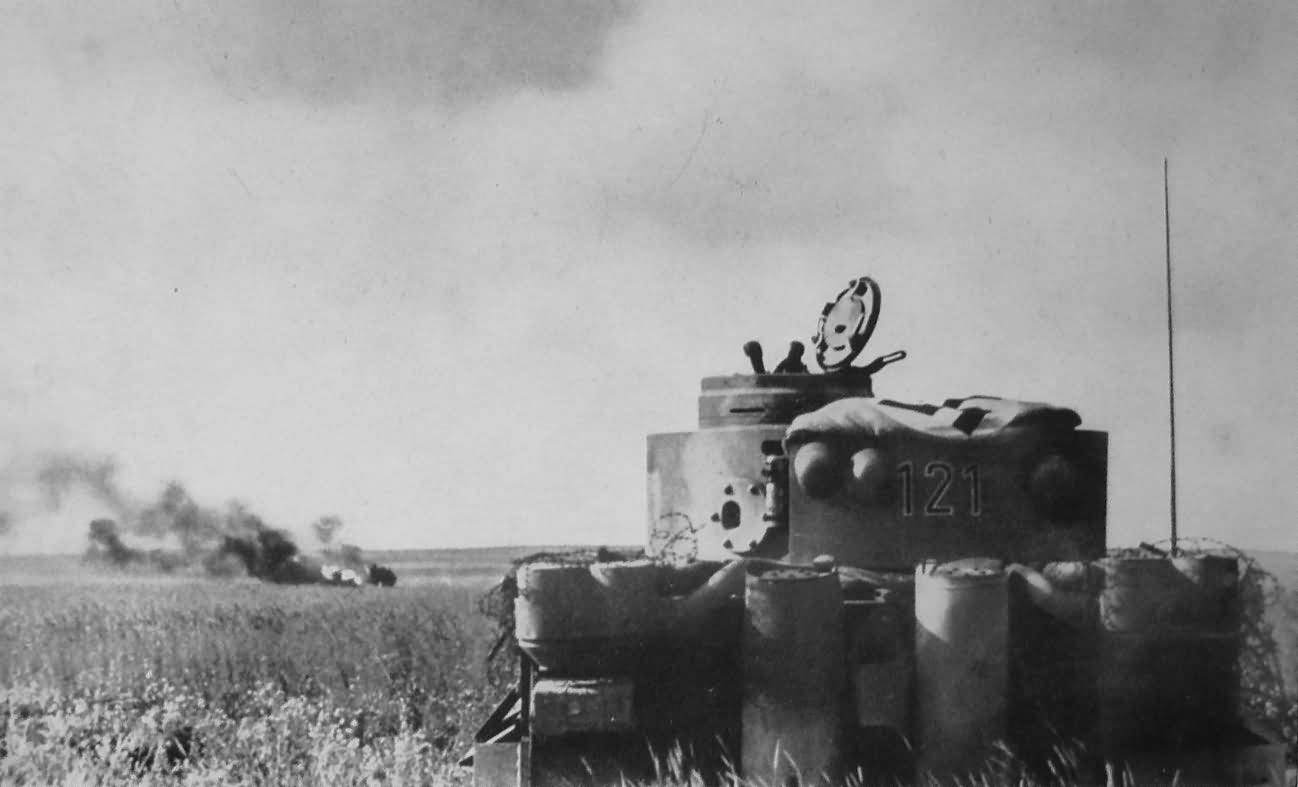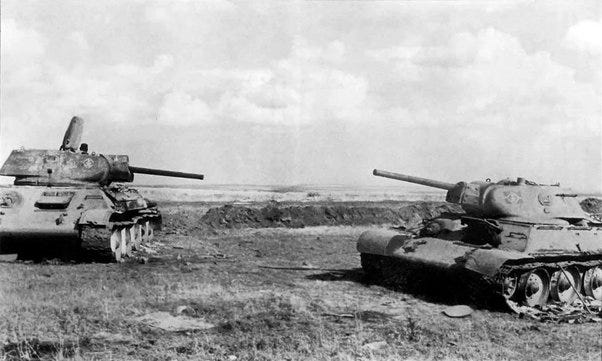Red Army Rising: Kursk and Beyond
The History of Battle: Maneuver, Part 15
How do you fight a war that you cannot win?
It’s an interesting question. Perhaps the question presupposes that the inevitability of defeat is obvious and well understood, but let us just presume - you know that victory is beyond reach, so how do you keep fighting? In our more level headed moments, we would say that the best thing to do would be to negotiate. After all, once the point of no return has been reached, continuing to fight only means wasting lives and probably angering the enemy more, bringing down more wrath on your head in the end.
Yet one of the quirks of history is that surrender is generally the object of shame, and is almost never applauded for its prudence. In the best examples, where a defeated state saw the handwriting on the wall and surrendered without dragging out the misery, the aura is one of cowardice, betrayal, and humiliation - think, for example, of France in 1940 or Germany in 1918. In the German case, it was plainly obvious that Germany could not win the war, and yet surrender plunged the country into decades of shame, resentment, and hysteria over the supposed “betrayal” of the army.
Perhaps the lesson is simply that defeat is defeat, and there is no good way out. Negotiation and surrender will risk allegations of cowardice and betrayal and will subject you to the whims of the enemy, but neither does fighting to the last man seem to be a good solution. Maybe this is simply what it means to lose.
But in any case, suppose that you have chosen to fight. How do you do it? When victory is gone, how do you even frame your operational objectives? Do you openly state that your goals are to die and take as many of the enemy with you as you can? Do you aim to achieve some sufficient battlefield success so that the enemy will give you better terms? Or do you blind yourself to the overall strategic situation and give yourself over to pure action - turning warmaking into a mechanical activity devoid of strategic meaning?
Maybe the answer is all three, or at least some combination therein. In the case of Nazi Germany, all of these elements seemed to be at play. Some German commanders spoke of their fight as a “delaying action” - which sounds reasonable, but delaying what? Death? This sounds less nice, and implies that they sacrificed millions of men so that Hitler could avoid killing himself for a few extra months. Others detached themselves from the broader geostrategic disaster and became psychically embedded in their operations - blinding themselves to all but the enemy and their situation maps. Others were released from the psychological burden of fighting a lost war - tens of thousands of German officers would die as the Wehrmacht was chewed up at an ever increasing pace. A few channeled their energies inward and tried to kill Hitler, but most did not. For the most part, the German officer corps was determined to fight to the end. There would be no cracks, no surrender, no betrayal as there had been in 1918.
Germany tried the path of surrender in 1918 and found it distasteful. In 1943 and onward, they chose to fight a lost war with increasing savagery and in the face of an increasingly totalizing geostrategic catastrophe. They found that fighting a lost war is much harder and less romantic than it sounds, and instead of reliving the shame of Versailles they willingly dragged Germany into the most comprehensive military defeat in modern history.
Planning a Lost War
The Battle of Kursk has tremendous cachet and name-recognition among devotees of military history. The mere mention of the name Kursk is almost sure to invoke the classic, almost reverent response - the greatest tank battle in history! The idea of an enormous tank on tank clash is certainly exciting, made all the more cinematic by the presence, for the first time, of the iconic late-war German tank models like the Panzer V Panther and especially the Tiger, which remains one of the most famous and beloved articles of military hardware in history (yes, tanks are beloved - don’t ask).
If Kursk retains an undeniable element of excitement and climax today, in real time excitement was the farthest thing from the minds of the German officers who planned the operation.
The Wehrmacht faced an unenviable situation in the spring of 1943. A year ago, they had wrestled with the prospect of waging a full-spectrum strategic defense of their European Empire against a powerful Anglo-American coalition. A daunting prospect, to be sure, but they had found solace in a few optimistic propositions. First, they believed (or at least hoped) that it might be a matter of several years before the Americans could project force into the European theater. Surely the Japanese would keep them tied down for a while? This lag period while American combat power came online would, hopefully, allow the Wehrmacht to finalize the defeat of the Soviet Union, consolidate control over Soviet natural resources, and prepare for the siege of Europe.
Instead, things had gone from bad to worse. The powerful Japanese momentum which Germany had banked on to delay American entry in Europe had collapsed with shocking speed. The Japanese carrier forces had been smashed at Midway in June, and American mobilization had been faster than expected. By November there were already American troops in North Africa, and although the American army struggled in their first operations, they had gotten into the fight far too fast for Berlin’s comfort.
But that was only the half of it. The real trouble was in the east. Army Group South had expended enormous energy trying to reach the Caucasus with nothing to show for it, and after the disaster at Stalingrad it had taken a herculean effort by Manstein and his staff just to save the army.
So, there it was. After driving hundreds of miles east and then hundreds of miles back to the west, the Wehrmacht had essentially wasted 1942, lost hundreds of thousands of men, and burned through huge amounts of material just to end up defending a line almost identical to the one they’d occupied at the start of the year. In territorial terms, 1942 was essentially a wash, with the Red Army and the Wehrmacht returning roughly to their starting positions, but the geostrategic situation had deteriorated rapidly for Germany. They now faced twin dooms - both a rapidly approaching Anglo-American invasion of Europe and laughable overmatch by the Soviets in the east. Like a patient riddled with diseases, the question was not so much whether death was approaching, but when it would come and which particular pestilence would deliver the killing blow.
The scale of the overmatch on the Eastern Front is, for us, baked into the situation maps by the scale by which the two armies are identified. It is common (as in my map below) to continue to locate German field armies - multidivisional formations that might be up to several hundred thousand men. The Red Army, on the other hand, had by this time reached such an extreme level of force generation that it is generally mapped in fronts, which was the Soviet parlance for an Army Group. By June, 1943, the Wehrmacht had 11 frontline field armies in the east, which were lined up across from no less than ten Red Army fronts.
In a sense, virtually every German unit corresponded to a Soviet formation that was at least a full level of organization higher than itself. Just for example, the newly reconstituted German 6th Army (guarding a line on the Mius River on the far southern end of the front) was arrayed against the Soviet Southern Front, which had five field armies in its order of battle. In total, a spring inventory counted 147 infantry divisions in Germany’s eastern army, with the corresponding Soviet count at a whopping 504. The disparity in tanks and aircraft was similar. In total, Soviet manpower on the frontline was roughly twice that of the German eastern army, and the Soviets furthermore had nearly four million men in available reserves - needless to say, the Germans did not. The Red Army by this time had also come to fully embrace the role of artillery, and Soviet forces routinely enjoyed a 5 to 1 superiority in tube and rocket artillery. There really was nothing to be done for the Wehrmacht in this situation - let alone with the Anglo-American coalition forces in the wings.
So, there it was. The war was lost, but it still had to be fought anyway. How does one plan a losing war?
With considerable difficulty, as it would turn out.
Conceptually, Germany’s Kursk Operation - Operation Zitadelle (Citadel) as it would eventually be named - is perhaps one of the easiest battles in history to understand. Manstein’s lively counterattack in Central Ukraine during the winter had driven the Red Army back over the northern Donets River and regained the cities of Kharkov and Belgorod. However, due to the general weakness of the German formations further north, a synergistic attack towards the city of Kursk had been called off. As a result, the Red Army occupied an enormous bulge, or salient centered around Kursk. A salient like this would naturally draw the eyes of any planning team, and in this case the target was particularly attractive because the Wehrmacht controlled cities - Orel and Belgorod - directly on the “shoulders” of the bulge. Kursk also happened to lie on the operational boundary between Army Group Center (under Field Marshal Günther von Kluge) and Army Group South (under Manstein).
The conception was therefore fairly straightforward. An army from each of the two army groups would attack across the base of the bulge, attempt a linkup in the rear, and destroy the encircled Soviet forces inside the salient. Surely such a simple and obvious operation would have been easy to plan?
In fact, despite being one of the most schematically simple operations of the war, Citadel had one of the most tortured planning processes, which revealed the increasingly cursed position that the Wehrmacht found itself in.
The genesis of Citadel actually came in March, as Manstein was triumphantly driving the Soviets back over the Donets. Manstein wanted to keep the momentum going, and immediately saw the potential for forces from Army Group Center to provide a northern pincer in a concentric drive on Kursk - but he envisioned this as a continuation of his counterattack, rather than a discrete operation which would have to be planned and prepared for at a later date.
However, Manstein’s plan to keep rolling ran into two insuperable obstacles. The first of these was the onset of the mud season, which locked the front up during the spring thaw and forced the two sides to lick their wounds. The second and more enduring problem was the simple fact that German combat power was shockingly degraded. Manstein’s own Army Group had been all over the map - starting on the Donets in the spring of 1942, fighting all the way to the Volga and the Caucasus, retreating practically back to the Dnieper, and then counterattacking back to the Donets. Keeping up “momentum” sounds well and good, but Army Group South was in no condition to continue attacking. Army Group Center had issues of its own - largely the fact that it had been deprioritized in 1942 and had been stripped of most of its panzers.
So, between mud and insufficient fighting power, Manstein’s plan to keep the attack going had to be shelved - but the Kursk salient was still there, and something would have to be done about it.
This was where the trouble began. It was one thing to swoop down on Kursk during the fluid operational situation, but it was entirely another matter to launch an attack after an operational pause. The crux of the matter was that Kursk was such an obvious place to attack that there was little chance that the Red Army would fail to prepare. Indeed, on April 8th Marshal Zhukov informed Stalin that the Germans would launch “a two-pronged movement to envelop Kursk” and that counteracting preparations would be made. The timing is interesting - “Operational Citadel” was named for the first time in an operational order issued by Hitler’s headquarters on April 5th. The implication is that the Soviets began preparing to counter the German attack at essentially the same time that the Germans were planning the assault.
Hence, Operation Citadel threatened to become little more than a frontal assault against a fully prepared and alert enemy defense - precisely the sort of action that German officers found anathema. There was really no “operational art” here, no maneuver, simply taking a battering ram to the single most obvious sector of front - a sector that the enemy was rapidly turning into a fortress.
By late April it was already becoming apparent (as aerial reconnaissance confirmed) that the Kursk salient was being absolutely packed with Soviet forces who were in the process of preparing elaborate defensive belts. In time, the Kursk salient would be stuffed to the brim with antitank guns and artillery pieces, until it resembled nothing short of a high explosive porcupine. It is not an exaggeration to say that by summer the Kursk salient had been turned into the most heavily fortified and armed section of land on earth - a veritable “anti-tank fortress.”
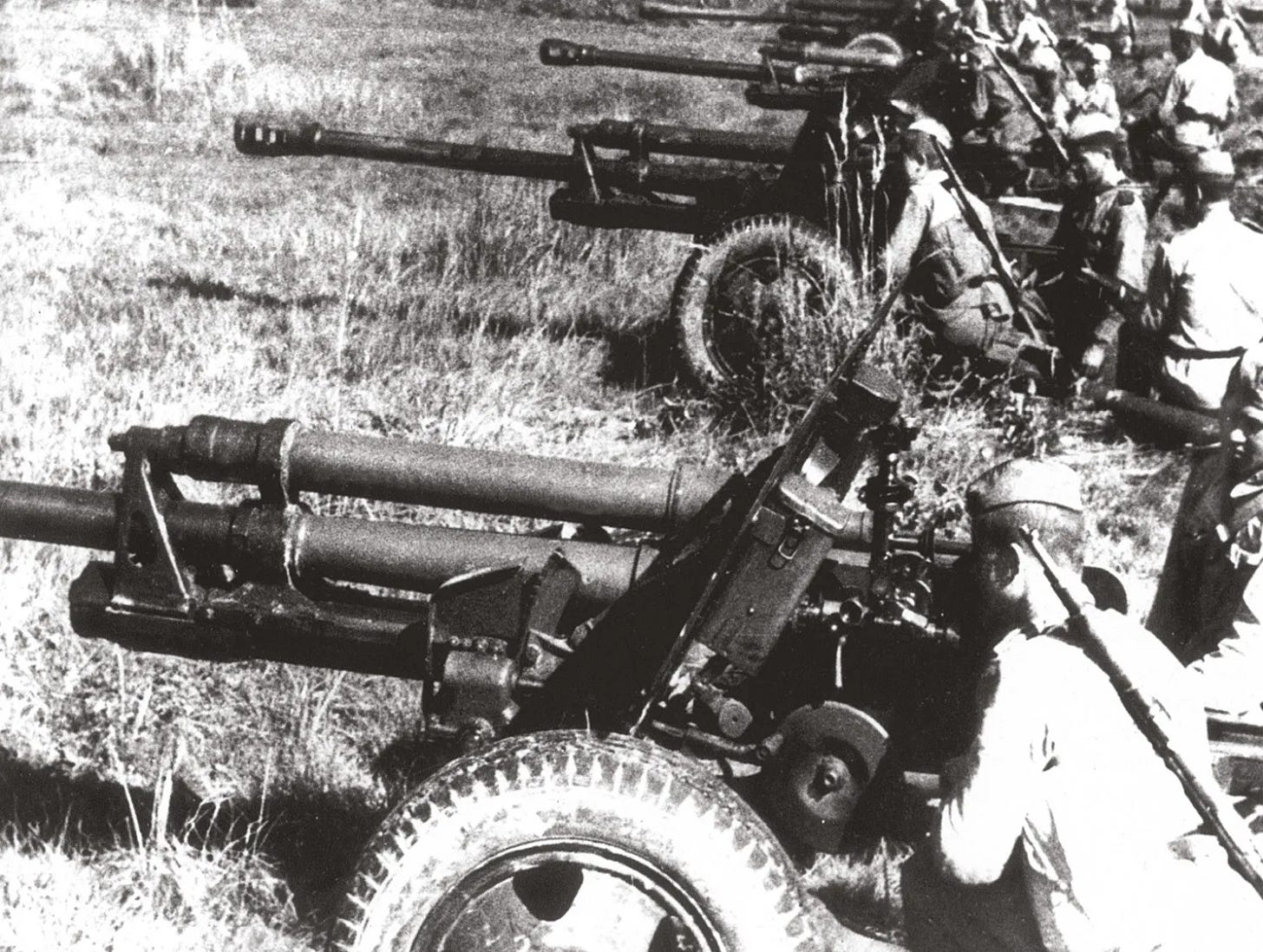
And so, the Wehrmacht was caught in an unsolvable problem, rooted in the basic fact that the Soviet Union could generate combat power far faster than Germany could. It sounds all well and good to use an operational pause to build up more forces for the attack, but in this case the force ratios turned more and more against Germany’s favor the longer the attack was postponed. The trajectory clearly dictated that, no matter what the Germans did, the Soviets would have a clear force advantage against any attack on the Kursk salient.
The fundamental problem of Operation Citadel was probably expressed the most explicitly and succinctly by the head of Military Intelligence for the eastern army, General Reinhard Gehlen:
The Russians have been expecting our attack in the relevant sections of the front for weeks and have done everything, with characteristic energy, to absorb it at an early stage both by building several successive defensive positions and by an appropriate deployment of forces. There is therefore little likelihood of a German breakthrough. Nor can it be expected, given the quantity of reserves at the Russians’ disposal, that CITADEL will inflict such great losses on them as to prevent them from pursuing their general intentions at the desired time owing to insufficient numbers. On the German side, the reserves which will be sorely needed at a later stage in view of the overall position (situation in the Mediterranean!) would be deployed and used up. I consider the envisaged operation a critical error of the highest order that will have very serious consequences.
There are no flaws in Gehlen’s assessment. Yet Citadel went ahead.
Was this really the best they could do? How could this Wehrmacht - which had garnered such a reputation for creativity, agility, and mobile warfare - really have no better ideas than a frontal attack against a superior enemy that was fully alert to their plans? It was not merely that the Soviets knew that Citadel was coming - the Germans knew that they knew it, and were fully aware that the Red Army was preparing for the defense of the salient. So why did they attack at all?
As the war went on and increasingly turned against Germany’s favor - and eventually to Germany’s ruin - it becomes common for the historiography to speak of the Wehrmacht becoming increasingly Hitler-ified - that is, it became less intelligent and operationally minded, less willing to maneuver deftly, and more focused on a brutal “stand in place and fight” model. This of course coincides with Hitler’s serial dismissal of officers and his central role in the planning process.
Kursk, therefore, tends to fit the bill as an iconic “Hitler” battle. The operational conception was very simple, in the end amounting to little more than a frontal attack against a seemingly impregnable Soviet defense. An ill-advised operation if ever there was one - surely this one has Hitler’s fingerprints all over it?
We must consider the planning process in the full context of Germany’s war. Hitler, of course, was the commander in chief and thus bears ultimate responsibility for the woes inflicted on and by Germany (this is what it means to lead) but an examination of the planning process reveals that Germany’s strategic impasse had brought military leadership to a state of paralysis.
Citadel had roughly been identified as a key action item for the year, but there was a great deal that remained unsettled. A critical staff meeting was held in Munich on May 3-4. The discussion, which was recalled in the memoirs of virtually all the relevant attending personnel, presents a scene radically different from the stereotype - neither the imperious, bullying Fuhrer nor the competent and visionary officer corps was in attendance.
Hitler, rather remarkably, was something of a non-entity at the conference. There was no monologue, he did not issue a firm directive, and he did not directly contradict or argue with any of his subordinates. Instead, he presented the outline of Operation Citadel, as first conceived by Manstein in March and then formally drafted by the Chief of the General Staff, Kurt Zeitzler. The plan was presented neutrally, with Hitler neither backing nor opposing it. The discussion then went around the room, and the variety of opinions voiced were surely disquieting to an already unsettled Fuhrer.
General Walter Model (whose 9th Army was to form the northern pincer of the attack) was concerned that his force was not strong enough to breach the Soviet defense, and wanted to postpone the attack until he had taken delivery of the new Panther and Tiger tanks. Manstein, in contrast, was in favor of the operation only if it could be launched immediately (April would have been even better, he added) due to the ongoing Soviet reinforcement of the Kursk salient. Field Marshal Kluge of Army Group Center (Model’s boss) supported the operation unequivocally. Heinz Guderian (now promoted to general inspector of the Panzer Troops) opposed the operation categorically, and wanted to hoard Panzers to create a mobile reserve for defensive operations. Albert Speer, in charge of armaments production, opposed the attack. The Luftwaffe Chief of Staff, Hans Jeschonnek, supported the attack but was against delay.
This was a bad sign. These were experienced and extremely competent officers trained to view war in a particular way, but the broader strategic situation was becoming so dismal that - given license by Hitler to speak honestly - the war council could settle nothing. All the choices were bad. Model was right: 9th Army was too weak to break into the salient. But Manstein was also right: every week of delay allowed the Soviets to make the salient more impregnably. Perhaps most importantly, there were no alternatives suggested: the choice was between the Kursk operation and simply sitting in a defensive stance and waiting for the Red Army to take the initiative.
We can see, then, how the Germans arrived at the Battle of Kursk as a sort of default option. There was limited enthusiasm for the operation, and the continued shortages of material and fighting power led to a series of postponements. Ironically, however, every postponement made it more difficult to call the operation off, because the Wehrmacht continued to send men, equipment, and supplies to the staging areas. Calling off the operation in April when minimal preparations had been made would have been one thing; calling it off at the end of June after spending months staging the assault forces was entirely another. Manstein would eventually suggest to Hitler that Citadel be scrapped so that Panzer forces could be used for a mobile defense, but this was a nonstarter. The Kursk operation had been Manstein’s idea in the first place - how, after three months of planning and stockpiling, could he now suggest ditching it?
Thus, a battle that nobody particularly wanted ended up consuming a huge amount of German fighting power and mental energy. The Wehrmacht was trapped in a doom loop of cognitive paralysis. Indecision led to delays, delays led to further investment of time and resources, and these investments created a sunk cost fallacy that psychically locked them into the plan.
Ultimately, we can see Operation Citadel as a manifestation of German military instinct in the face of a catastrophe. The Wehrmacht had fought its way into an impasse - overmatched by the Red Army, ejected from North Africa, with the Anglo-Americans threatening offshore. The roof was threatening to cave in all over the place. Crisis bred command paralysis. Facing (but not admitting) the obvious truth that it was impossible to win the war, the Wehrmacht attacked the single most obvious section of the front in an act of pure instinct.
On May 10, Guderian had a short but telling conversation with Hitler. “Why are we attacking in the East at all this year?” he asked. “Do you think anyone even knows where Kursk is?” Hitler replied, “You’re right. Whenever I think about this attack, my stomach turns over.” But the planning and preparation had a momentum of its own that Hitler lacked the willpower to arrest.
Operation Citadel
By the time Citadel was finally ready for launch on July 5th, the Wehrmacht had managed to assemble a genuinely impressive strike package. Although each of Citadel’s pincers was to consist of a single field army, these had been repeatedly beefed up throughout the many delays. The northern pincer - Model’s 9th Army - had ballooned up to a nineteen division behemoth with nearly 700 tanks in its inventories, plus a bevy of assault guns and other mechanized elements. The southern pincer - Hoth’s Fourth Panzer Army - was even more nasty, as it included the 2nd SS Panzer Corps. This was perhaps one of the single most powerful German formations of the war, with three SS divisions which enjoyed privileged access to recruits and new equipment, including the new Tiger tanks.
Altogether, the Wehrmacht managed to assemble some 630,000 men for Citadel, with 2,700 tanks and assault guns, 9,500 cannon, and a powerful concentration of Luftwaffe air support. Given the overall state of Germany’s strategic position, this was an exceptionally powerful force accumulation.
It was absolutely dwarfed by the Soviet preparation. To counter these two German field armies, the Red Army had packed the salient with three whole army groups (fronts). Center Front (six armies, 700,000 men, and 1,800 tanks) lined up across from Model’s 9th army in the northern wedge of the salient, and Voronezh Front (6 armies, 625,000 men, 1,700 tanks) guarded the southern line across from Hoth’s Panzer Army. Finally, the Steppe Front (six armies, 575,000 men, and 1,500 tanks) loitered in the rear as an operational reserve. Germany had no meaningful operational reserve in the theater at all.
And so, after months of hand wringing, delays, and obsessive preparation, the Wehrmacht launched a frontal attack against a fully prepared enemy position, in which the enemy enjoyed a force advantage of at least 3:1 in every major arm. The Red Army not only anticipated the general nature of the German operation, but also the particular sectors where the Germans would attempt to breach, and even the date of the operation’s start: Soviet artillery and air assets were active from the first moment of the German assault.
The German attack utterly failed to break through the Soviet defenses. The most we can say is that they broke into them. The Kursk salient had by this time been fortified with no less than eight sequential defensive belts, each bristling with prepared firing positions, antitank guns, trenches, ditches, and thousands upon thousands of mines. The Wehrmacht, which had previously measured its advances in hundreds of miles, now failed to get any momentum at all and almost immediately became entangled in material-heavy positional fighting.
The basic dynamic of the Battle of Kursk and the Soviet defensive scheme can be elucidated as follows.
Minefields and prepared fortifications forced the Germans to repeatedly confront complicated combat engineering problems to advance successfully. Soviet defenses wove minefields and anti-tank ditches into a complicated maze of obstacles, which created a complex engineering and navigation problem that would have slowed the German advance even in the absence of defensive fighting.
The echeloned Soviet defensive belts made exploitation impossible; even where German groupings managed to create a breach and leap forward, the advance became a stop-start affair.
Powerful Soviet strongholds that were cost-prohibitive to storm repeatedly forced German commanders to stop and seek alternative routes to bypass these strong fortresses.
German breaches were consistently counterattacked by Soviet reserves, making it difficult to pull large forces through the breach. Almost immediately after breaching a defensive position, German forces would find their lead elements coming under attack.
Counterattacks against the flanks of the German advance forced the lead German elements to bleed strength, dropping off forces to protect their flanks as they went.
This was unequivocally the most intelligent and effective defense that the Red Army had yet fought, and the Germans quickly realized that this battle was nothing like the mobile campaigns they had fought in previous years. The Germans never really did maneuver at all, because they never got free of Soviet forces and defenses. They’d concentrated enormous fighting power in very small sectors, and this did allow them to move forward at a slow and costly pace, but as they advanced they never got free of the Soviet defenders. Instead, Soviet fixed defenses and counterattacking forces stuck all over their front. The advance was rather akin to trying to walk through a dense mess of cobwebs - it is possible to move forward, but the webbing gets gradually more and more splattered and stuck all over. The overall effect became powerfully claustrophobic and constraining.
The suffocating nature of the Soviet defense bred, for the first time, a measure of tactical uncertainty in the Germans. The German mechanized package had always worked like clockwork. The basic Panzer assault had never really had problems breaching enemy positions - the main problem for the Germans was always that there simply weren’t enough Panzer divisions to go around. At Kursk, however, the German tactical system was for the first time thrown into question.
The German pincers were commanded by two of Germany’s best commanders - Hermann Hoth in the south, and Walter Model in the north. Both were hard driving and aggressive commanders, but the Soviet defenses proved flummoxing, and they chose different tactical methodologies. Hoth was a Panzer man through and through - he had been commanding Panzer groups for years at this point - and, wielding perhaps Germany’s strongest panzer force of the war in the 2nd SS Panzer Corps, he chose to use tanks as his spearhead breaching asset. Model, on the other hand, did not want to lose tanks trying to break fortified positions - he wanted to conserve them for exploitation once the Soviet lines were breached. Accordingly, while Hoth’s assault in the south featured tanks in the leading role, Model leaned more heavily on infantry, artillery, and engineering units.
The differing tactics speaks to the general fact that the Wehrmacht was having an unusually difficult time making progress, and its normal toolbox did not seem to have an obvious answer to the problem. It was not so much a question of whether Hoth or Model had the correct approach - the simple fact that these experienced and confident commanders could not agree on an obvious tactical approach was foreboding. Slowly making their way through a maze of Soviet defenses and facing constant counterattacks, the Germans plodded forward, making at best a few kilometers of progress per day. Model’s group, after nearly a week of hard fighting, had penetrated less than 20 kilometers into the Kursk salient, and had wasted two days (July 10 and 11) trying and failing to capture a Soviet stronghold on fortified high ground.
And so, by July 11th Model’s attack had firmly stalled. He still had some unspent forces left to feed in, and was busy with his staff trying to plot a way to go around the fortified high ground which had already cost him two days and a substantial amount of combat power. Maybe he could find a seam, a weak spot, a hole in the defense and finally break into the open? The northern pincer was stalled, but perhaps not entirely dead?
Yet, even in this optimistic view of the situation, Model had to admit that he was trapped in a “rolling battle of attrition.” This was not mobile warfare at all - it looked nothing like the sweeping German campaigns of the previous years. Model had seen this kind of fighting before though - when he was a young man, only a Lieutenant, at the Battle of Verdun.
Meanwhile, in the south, the 2nd SS Panzer Corps was fighting a different kind of battle entirely.
The Tank Fan’s Delight: Prokhorovka
I generally try my best to shy away from “debunking” historical mythology, at least in an overt and condescending way. Our world already has far too many obsequious and self absorbed “fact checkers” and “debunkers” and they are generally the sort of people that nobody likes. Therefore, we will tread gently as we address what is probably the single most famous tank engagement of all time - the clash between the 2nd SS Panzer Corps and the 5th Guards Tank Army on the fields outside the small village of Prokhorovka on July 12, 1943.
There is absolutely no denying that Prokhorovka was a genuinely tremendous fight, involving many hundreds of vehicles, characterized by close range tank on tank combat, and for that reason alone it probably ought to satisfy all the tank aficionados to some extent. What the battle was *not*, however, was a particularly important engagement. Nor was it a Soviet victory - arguably, it was the Red Army’s worst misfire in the Battle of Kursk. Rather counterintuitively, in fact, the fame of Prokhorovka is largely due to propagandistic efforts of the Soviet officer who committed the blunder.
Let us elaborate.
The actual events that led to the fight at Prokhorovka are relatively straightforward. 2nd SS Panzer Corps under General Paul Hausser was the single most powerful formation in Operation Citadel, and accordingly it had made the best progress, though its penetration was still shallow at only 25 miles after 10 days. Meanwhile, the powerful Soviet 5th Guards Tank Army under General Pavel Rotmistrov was pulling up into position on 2nd SS’s right, aiming to counterattack against the approaching SS spearhead. Catching wind of their approach, Hausser wheeled right to meet them. By happenstance, the 5th GTA pulled out of their staging area at the village of Prokhorovka (itself little more than a name on the map) and ran directly into Hausser’s lead elements. In this way, an entire Panzer Corps and an entire Tank Army crashed into each other and inadvertently began the world’s most famous tank duel.
The scene must have been cinematic and terrifying; thousands of tanks colliding in a confined space, firing and driving frantically around trying to find soft spots - even ramming each other! Rotmistrov’s forces would report destroying 400 Panzers, and he described the scene thusly:
Dead bodies, destroyed tanks, crushed guns, and numerous shell craters dotted the battlefield. There was not a single blade of grass to be seen: only burnt, black, and smoldering earth throughout the entire depth of our attack—up to eight miles.
Wow!
Except it did not really happen this way. For one thing, the entire 2nd SS Panzer Corps only had 267 tanks, and so it’s not quite clear how Rotmistrov got to 400 kills. In fact, the German ledger shows a much more modest number of irretrievable tank losses at… 3. There’s a big difference between losing 400 tanks and losing 3. Clearly somebody has some explaining to do.
What actually happened was not the outright collision of two enormous tank masses, but an ill advised frontal assault by Rotmistrov. When the 5th Guards Tank Army began its assault at 7:30 in the morning, most of the SS men were asleep. Rudely awakened by the sight of Rotmistrov’s lead corps barreling down the road in a mass, the Germans sorted themselves out for fighting.
The tactical dynamic of the ensuing fight was dictated by two structural issues. First, the Soviets were the ones attacking (or counterattacking, if you will) which meant they were the ones coming out to meet the Germans. As a result, the Soviets had to wind around their own anti-tank ditches. These ditches prevented them from driving straight towards the Panzers and forced them to take circuitous routes that left them exposed to fire for longer. In essence, many of the Soviet tankers spent the battle navigating a maze of ditches while being shot at. The second structural factor was the technological gap that now existed between the tank forces.
Kursk is traditionally celebrated as the coming out party for the German Big Cats: the Panzer V Panther and the world famous Tiger. Let us say a few words about the latter magnificent machine.
In 1941, the Wehrmacht found the quality of Soviet armor to be a nasty surprise, and were frustrated by the inability of many of their anti-tank weapons (like the 37mm PaK) to reliably penetrate the armor on vehicles like the T-34 and KV1. In response, the Wehrmacht asked manufacturers Henschel and Porsche to submit designs for a heavy tank that could mount a derivative of the high powered 88mm gun which was already in use for flak and anti-tank purposes. Although the original specifications called for a 45 ton tank, Henschel’s winning design - the Tiger - would come in at a whopping 57 tons. The Porsche design, despite losing the bid, would be converted into a limited run of enormous assault guns fittingly nicknamed the Elephant after weighing in at 68 tons.
Now, if you are not a tankophile, perhaps these weights don’t impress you, but context reveals the Tiger to be an absolutely colossal beast. The largest early war German tank model, the stalwart Panzer IV (the Honda Accord of Panzers) weighed in at a modest 25 tons, while the better armored Soviet T-34 clocked just under 31 tons. The American Sherman weighed 33. In fact, even modern tanks are not appreciably heavier than the Tiger - both the British Challenger and the German Leopard come in at around 62 tons. The weight of the Tiger was mindboggling considering the engineering constraints of the day. To move that 57 ton burden, the Tiger’s engine could put out only 690 horsepower (compare to the 1500 HP engine inside a modern Leopard).
By the standards of the day, then, the Tiger was an enormous tank (the Panther, at 43 tons, was lighter than the Tiger but still much beefier than competitors). This tremendous weight came with the advantage of armor that was on average around 60% thicker than a T-34’s, and an absolutely mammoth main cannon (the Tiger’s 88mm shells weighed more than twice as much as the T-34’s 75mm ordnance).
There were countless drawbacks to the Tiger, of course, and these drawbacks mattered a great deal in the broader context of the war. It was expensive both to build and maintain, which limited its production and combat availability. The transmission, suspension, and overlapping road wheels were overengineered and chronically problematic for maintenance teams. It was a fuel hog that broke bridges with its enormous weight. The sheer size of the thing made it troublesome to rail to the front and even more difficult to tow away in the event of a breakdown or damage. All things considered, it was a horribly annoying machine to build, move, and maintain.
These things, as we said, mattered in larger picture. On the field at Prokhorovka, however, what mattered was that the Tiger could very easily knock out a T-34 with a frontal hit from 2,000 meters away, while the Soviet tanks could not reliably pierce the Tiger’s front armor at any distance.
And so, at Prokhorovka, General Rotmistrov had launched what amounted to a massed frontal charge against an enemy which had in its inventories tanks that he lacked a realistic way to kill. Although Tigers and Panthers formed only a portion of German inventories, the balance largely consisted of new-model Panzer IV’s, equipped with long barrel 75mm guns that, while not as punchy as the Big Cats, still had a 700 meter range advantage on the T-34’s.
Only the night before the engagement, Rotmistrov had spoken with his boss, General Nikolai Vatutin (commander of the Voronezh Front). Vatutin had acerbically told Rotmistrov that if his forces encountered any of the new German tanks, their best option was to “engage in hand-to-hand and board them.” He was being sarcastic, but the real point was that the Soviet tankers had to close to point blank range to have any real chance of knocking out the new German models.
Accordingly, that morning at Prokhorovka, the attacking Soviet tanks had to rush at full speed, weaving around their own anti-tank ditches, to close with Hausser’s panzers. German crews described the attack as a seemingly suicidal action, but for Soviet tank crews ordered to attack head on, the only real option was to try and close the gap. This, in effect, turned the field into a shooting gallery for the Panzers.
Soviet losses at Prokhorovka were horrible all over the field. Two armored companies (consisting of 14 Panzer IVs and a mere 4 Tigers) reported destroying “hundreds” of Soviet tanks. The figure seemed so unbelievable that General Housser initially dismissed it as rubbish and drove up to their position to see for himself. Sure enough, Soviet figures (unavailable to the Germans but available to us) confirm that the 29th Armored Corps (Rotmistrov’s spearhead element) lost 172 of its 219 armored vehicles in the opening charge.
All told, Rotmistrov’s 5th Guards Tank Army lost at least 250 tanks at Prokhorovka, and only destroyed 3 Panzers - a further modest number of German vehicles were damaged, but were towed away for repairs and a return to action. The upshot of the day was an incredibly foolish head on assault by the Soviet tankers against technologically superior German vehicles. The scene certainly would have been shocking and thrilling enough, but this “tank duel” largely consisted of the Panzers sitting in a defensive stance taking potshots at the T-34s as they futilely tried to close the gap.
So how did this one-sided affair turn into the famous story of the world’s greatest tank battle? For that, we can thank Rotmistrov himself. He had been the only commander in the entire Kursk operation foolish enough to throw his forces across open terrain into a head-on assault on the new German tanks - and worst yet, he chose to pick a fight with the best equipped formation in the German assault package. Other Soviet commanders fought a more cautious and defensive battle and were able to blunt the German advance in a much less costly manner.

In a sense, this reflects the general principle that prudent and technically sound fighting is always less sexy and cinematic than higher risk (and costlier) action. Perhaps the idea of sitting in a prepared gun pit and firing antitank rounds from cover is less exciting to readers than sending hundreds of tanks straight into German firing lanes, but it is a better way to fight. Ironically, Rotmistrov’s attack at Prokhorovka is the most famous single engagement of the Kursk operation precisely because it was the most ill advised, and he had to create the story of an enormous tank duel to save his career.
Rotmistrov benefited, however, from the fact that Operation Citadel was called off the day after Prokhorovka. Not because of Prokhorovka mind you, but the timing was a gift from above. Rotmistrov had to report huge losses among his tank forces, but he was also able to report that the 2nd SS Panzer Corps was withdrawing. Nevermind the fact that the Germans left with virtually all of their vehicles - what mattered is that they were leaving. It was relatively easy for him to connect the dots and claim that he had fought a huge battle and dished out damage as well as he’d taken it. The story was tacitly accepted by his superiors, including Vatutin and Stalin himself, because both had supported the idea of a big counterattack inside the Kursk salient. Rotmistrov was not punished for wasting his corps, and in fact would later receive a promotion, while the Battle of Prokhorovka entered the mythology of the war as the swan song of the Panzer force.
So Prokhorovka, far from being a climactic tank duel for the future of the world, was a tactical debacle for a Soviet tank army that flung itself headlong towards the Tigers, but it was a debacle that did not matter much in the end (except to the brave souls who perished), simply because the larger Kursk operation was dead in the water. For the SS tankers who shot up the charging Red Army tanks, it was a remarkable experience and no doubt a satisfying tactical victory - but it was soon swallowed up in an all-encompassing strategic defeat.
The Revenge of Reality
Keep reading with a 7-day free trial
Subscribe to Big Serge Thought to keep reading this post and get 7 days of free access to the full post archives.

